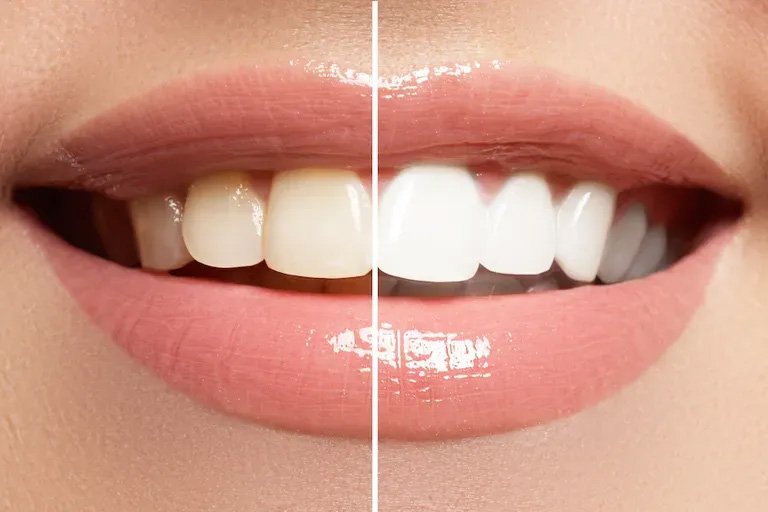A bright, radiant smile is often considered a hallmark of confidence and good health. However, over time, factors such as aging, dietary choices, and lifestyle habits can contribute to teeth becoming stained or discolored. Fortunately, modern dentistry offers a range of transformative teeth whitening solutions that can effectively restore a dazzling smile.
This article explores the causes of tooth discoloration, popular teeth whitening methods, considerations for choosing a treatment, potential side effects, and the future trends in teeth whitening technology.
Understanding Tooth Discoloration
Tooth discoloration can occur due to both intrinsic and extrinsic factors. Extrinsic stains affect the outer layer of the tooth (enamel) and are often caused by consuming dark-colored foods and beverages like coffee, tea, red wine, and berries. Smoking and poor oral hygiene habits can also contribute to extrinsic staining. Intrinsic stains, on the other hand, develop within the tooth structure itself and can be caused by factors such as aging, certain medications (like tetracycline antibiotics), excessive fluoride exposure during tooth development, or trauma to the teeth.
Professional teeth whitening treatments offer a comprehensive approach to achieving a brighter, more radiant smile under the supervision of dental experts. Conducted in a controlled environment, typically within a dental office, these treatments utilize higher-concentration bleaching agents that penetrate deep into the enamel to effectively lift stubborn stains caused by aging, dietary habits, or lifestyle factors.
Whether through advanced laser technology, custom-fitted trays, or specialized light systems, professional whitening ensures both safety and efficacy, minimizing the risk of sensitivity and maximizing results. Dentists tailor treatments to individual needs, providing personalized care that addresses specific concerns while enhancing overall oral health.
Popular Teeth Whitening Methods
- In-Office Teeth Whitening: Professional teeth whitening procedures performed in a dental office are among the fastest and most effective ways to achieve noticeable results. Dentists apply a high-concentration bleaching agent (often containing hydrogen peroxide or carbamide peroxide) directly to the teeth and may use special lights or lasers to enhance the whitening process. In-office treatments typically take about 1-2 hours and can lighten teeth by several shades in a single session.
- At-Home Teeth Whitening Kits: Over-the-counter (OTC) teeth whitening kits are another popular option for those seeking a more affordable and convenient whitening solution. These kits typically include a lower-concentration bleaching gel or strips that are applied directly to the teeth using trays or strips. While at-home kits may take longer to achieve desired results compared to in-office treatments, they can still effectively lighten teeth over the course of several weeks with consistent use.
- Whitening Toothpaste and Mouthwashes: Whitening toothpastes and mouthwashes are designed to remove surface stains using mild abrasives or chemical agents. While these products can help maintain whiteness and improve overall oral hygiene, they are less effective at treating deeper stains or achieving significant whitening compared to professional treatments.
Considerations for Choosing a Treatment
When considering teeth whitening options, it’s important to consult with a dentist to determine the most suitable treatment based on individual needs and goals. Factors to consider include:
- Severity of Staining: The extent of discoloration will influence the choice between in-office treatments for immediate results or gradual improvement with at-home kits.
- Sensitivity: Individuals with sensitive teeth or gums may benefit from gentler whitening options or professional supervision to minimize discomfort.
- Overall Oral Health: It’s essential to ensure that teeth and gums are healthy before undergoing any whitening treatment to avoid exacerbating existing dental issues.
Potential Side Effects
While teeth whitening is generally considered safe when performed under professional supervision or according to product instructions, some individuals may experience temporary side effects such as:
- Tooth Sensitivity: Increased sensitivity to hot or cold temperatures may occur during or after treatment, usually resolving within a few days.
- Gum Irritation: Whitening agents can sometimes irritate the gums, leading to mild inflammation or discomfort. This typically subsides once treatment is discontinued.
- Overuse Risks: Excessive or improper use of whitening products can potentially damage tooth enamel or cause uneven whitening. Following recommended guidelines and consulting with a dentist can help mitigate these risks.
Future Trends in Teeth Whitening Technology
Advancements in dental technology continue to drive innovation in teeth whitening, aiming to enhance effectiveness, minimize sensitivity, and improve patient comfort. Some emerging trends include:
- Laser and Light-Assisted Whitening: Continued research into the use of specialized lights and lasers to activate whitening agents, potentially reducing treatment time and enhancing results.
- Nano-Hydroxyapatite Technology: Development of whitening products that utilize nano-hydroxyapatite particles to not only whiten teeth but also strengthen enamel and reduce sensitivity.
- Smartphone-Compatible Apps: Integration of teeth whitening treatments with smartphone apps for personalized monitoring and treatment adjustments based on individual progress and preferences.
Conclusion
Achieving a stunning, bright smile through teeth whitening treatments is not just about cosmetic enhancement but also about restoring confidence and improving overall oral health. Whether opting for professional in-office procedures or convenient at-home kits, the journey from stained to stunning involves understanding the causes of discoloration, choosing the right treatment method, and considering potential side effects under professional guidance. As technology continues to advance, the future of teeth whitening holds promise for even safer, more effective, and accessible solutions that cater to diverse patient needs and preferences.



